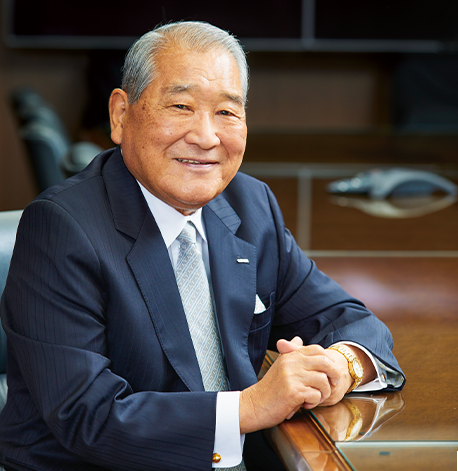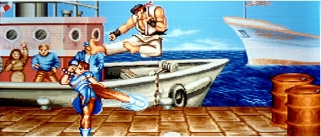- Value Creation Story (PDF)
- CEO
Commitment - Growth
Strategies - Financial Strategy
- Latest
Creative Report - Corporate Oversight

Generating world-class content to help build a richer society through a solid management base and our growth strategy.
Kenzo Tsujimoto
Chairman and
Chief Executive Officer (CEO)
To everyone fighting COVID-19
I wish to send my deepest condolences to everyone who has lost a loved one to the novel coronavirus and my most heartfelt wishes for a full recovery to everyone who has suffered from it.
When I look back on my career in management, I see that I have faced many crises, such as the bankruptcy of Lehman Brothers, as well as the Great Hanshin earthquake and the Tohoku earthquake and tsunami, both of which I personally experienced.
However, unlike the disasters and catastrophes that have taken place in the past, the COVID-19 pandemic is not a localized issue. Everyone in every region of the world is being affected by this crisis. Entertainment is not essential for life. However, in times like this, I believe that entertainment can bring people some joy and hope. It is my hope that our business activities bring the people of the world the energy to fight COVID-19.
I will now explain the ways in which we are demonstrating the superiority and uniqueness of the five elements that comprise the foundation of Capcom’s sustainable growth.
Creating the world’s most entertaining games to realize sustainable growth

Corporate philosophy and culture —— Our unwavering philosophy since the company’s inception
Aiming to be #1: delivering the best content "From Osaka to the world"
I jumped into the world of entertainment more than 50 year ago with the idea that “games are luxury items, not essentials. This is why the brand must be of world-class quality.” I still believe this to be true even today. Accordingly, Capcom’s basic philosophy is to create an entertainment culture through the medium of games by developing highly creative content that excites and stimulates your senses and brings a smile to your face.
In other words, we help make people happy and in turn build an emotionally rich society by creating the world’s most entertaining games.
CAPCOM IR [Corporate Information] Corporate Philosophy
In 1983, I founded Capcom under the motto of "originality and ingenuity," with the vision of developing games offering world-class quality.
Underpinning this was my belief that increasingly sophisticated graphics and more immersive worlds would eventually make games as moving and impressive for the world as a Disney film.
Thirty-seven years later under the banner of Capcom, I have amassed nearly 3,000 colleagues who share this vision. Under the slogan “From Osaka to the World,” these values have become our corporate culture, with (1) a spirit that is always eager to take on new challenges and (2) a sense of pride to constantly strive to be world-class deeply ingrained in every Capcom employee.
Again and again, we have been able to produce unique series that are globally recognized, including Street Fighter, Resident Evil and Monster Hunter, because of the fertile soil of a corporate culture cultivated over many years.

Business model —— Creativity and formidable IP assets
Maximizing utilization of high-quality content in a wide range of markets
Capcom’s strengths are (1) the development and technological capabilities to create the world’s finest, high-quality games and (2) numerous popular branded IP known the world over.
In addition, since fiscal 2011, we have hired over 100 new graduate developers every year in anticipation of focusing on in-house development, increasing our development staff to over 2,300 people (as of June 30, 2020) and further enhancing our strengths.
From game market characteristics and competitive factor analysis, the Consumer sub-segment has high entry barriers; combining the aforementioned strengths with our capital and the relationships of trust we have with hardware manufacturers creates significant competitive advantages (profitability). In addition, with the spread of PC as a game platform and the standardization of selling software digitally over the Internet, the home video game market that was once limited to only some developed nations has now expanded across the globe.
[Financial Analysis] An Analysis of the Market and Capcom (PDF: 80KB)
Furthermore, in businesses and sub-segments other than Consumer, our rollout of popular IP across multiple mediums contributes as a stable source of earnings. This is because, in addition to the fact that our IP consists of products developed 100% in-house, possessing numerous global IPs amplifies the effect of our multiple usage strategy. Additionally, expansion into other areas leads to increased brand value and subsequently an influx of new users to the game. In particular, marketing activities utilizing Hollywood adaptations of content further enhances the global competitiveness (brand power) of our IPs and maximizes synergistic effects.
In recent years, as a result of these sustained branding measures, we are increasingly seeing multiple generations of fans at event venues as IPs enjoying long-term popularity have firmly taken hold.
Disney, which I once aspired to emulate, began as a producer of cartoons and expanded all the way into the theme park business, growing into a giant in the world of entertainment. With our original content acclaimed throughout the world and the growth potential of our esports, mobile and licensing businesses, I am certain Capcom will be leading the charge into the coming digital age.

Key performance indicators (KPI) —— Commitment to stable growth in a hit-driven industry
Structural improvements and new criterion as we look to the future
1. Analysis of management performance in the fiscal year ended March 2020 (summary)
Our performance this fiscal year (ended March 31, 2020) exhibited an increase in operating income for the 7th consecutive year and all profit items, from operating profit downward, reached record highs; however, what I would like to draw attention to this fiscal year in terms of performance is decreasing net sales and increasing income. For this fiscal year, initially we had planned on a decrease in net sales due to (1) Monster Hunter World: Iceborne (MHW:I, herein) being the only new major title, and (2) it was not an entirely new title; it is a massive expansion of the previous title, Monster Hunter: World, and therefore the unit price was low. However, because (1) the ratio of highly profitable digital sales, many of which were for MHW:I, improved over the previous year, and (2) catalog sales (past titles, including rereleases, and HD versions), which were heavily digital, grew, we were able to achieve our 7th consecutive year of increased income as initially planned, despite the dip in net sales. In the past, the market forecast was unavoidably influenced by the number of major new titles being released that fiscal year, but I am proud to say that from this outcome we have demonstrated the returns of our model of building up our back catalog and shifting to digital sales, which we have been diligently promoting for some time.
2. Medium-term management goal assumptions and indicators (KPI)
(1) Management direction —— Thinking not two, but ten steps ahead
In respect to management, I am always thinking about things in terms of the future. For example, nearly 10 years ago I gave an interview to a business magazine where I said, "if we are able to sell world-class quality products at a low price digitally, we will see even greater improvement in our performance." At the time, packaged sales were the mainstream and there were very few customers who purchased digital versions, so that idea may have been inconceivable to most people. Also, because packaged sales were the mainstream, pirated versions of games prevailed in most developing countries, but I also spoke about how that "will become a sort of promotion if we look at in the long term." As a result, now that digital sales have spread throughout the world, we are selling more than 200 different games in countries and regions whose total outnumbers that of the United Nations’ membership.
Creating top-class content not only produced this fiscal year’s performance, it will be the tool that paves the way for our future. That is precisely why our management policy is to (1) create exciting, world-class content (IPs), and (2) maximize earnings by leveraging our rich library of IPs across multiple platforms and media, while (3) maintaining these policies to become a company of continuous, sustainable growth.
(2) Management goals
Since the fiscal year ended March 2018, our sustainable medium-term management goal has been to increase operating income each fiscal year. Rather than struggling to coordinate major title launch periods for this, we intend to take a natural approach of establishing a model of stable growth through build-up by expanding our title lineup, among other efforts, in order to enable institutional investors managing pensions and individual investors on fixed incomes to maintain long-term holdings with confidence. Thus far, we have not set forth a specific profit margin growth goal, but now that we can see the distinct results of the shift to digital, we have set a goal of 10% profit growth for each fiscal year.
(3) Key performance indicators (KPI) and shareholder value creation achievements
In terms of management, in addition to operating income (growth indicator), which is the basis of corporate earning power, and operating margins (efficiency indicator), which are the basis of profitability, I also place importance on current net income and cash flows, but our CFO offers a fully detailed account from a financial perspective.
Financial Strategy According to the CFO
Here, I will explain sales volume for game software, which I consider an important indicator for achieving 10% growth each fiscal year. With the shift to digital, Capcom’s operating margin has increased for four consecutive years since the fiscal year ended March 2017, but we are gradually approaching a ceiling to that growth. In order to continue achieving increased profits for the future, we need to increase unit sales and increase our actual net sales.
[Value Creation Story] Financial Highlights(PDF: 84KB)
Before we began the roll out of our full-scale digital strategy in the fiscal year ended March 2017, sales volume varied greatly depending on whether or not we released a new major title. However, in recent years, units sold displayed steady growth due to (1) enhanced digital sales, (2) longer product lives of major titles, and (3) the promotion of digital marketing and other measures. If digital sales continue to grow in the market, there will be a decrease in the circulation of used software, and the number of units sold will continue on to trend upward. I believe that by promoting these efforts, our vision of 50 million units in annual sales volume will eventually be attainable.
Furthermore, I believe that nurturing talent that can play an active role on the global stage, creating new markets with cutting-edge technology and creating social and economic value (creation of common value) through our business activities while at the same time building a healthy relationship with our stakeholders will lead to increasing our corporate value. Therefore, focusing on "S" (social) and "G" (corporate governance) of ESG, I recognize our critical issues as (1) developer numbers, (2) diversity, (3) support for education, and 4. the ratio of external directors.
[Value Creation Story] ESG Highlights(PDF: 236KB)
The game developing business has a relatively low environmental impact compared to other businesses in the manufacturing industry, therefore we do not have a specific "E" (environmental) indicator. However, if the digital shift that we are promoting spreads further, our impact on the environment will decrease with the reduced need for shipping and packaging.
It is my intention to achieve stable growth with a two-pronged approach comprised of a business strategy to create profits and an ESG strategy that supports our businesses.

Management strategy
—— Development and marketing strategy geared toward achieving stable growth
Reforming our development system and brand strategy to grow our strengths
1. Investing in human resources and development equipment to create world-class games
With 50 years of management experience in this industry, I have a keen awareness of the vital importance of technology that meets the highest standards in order to create the world’s most exciting games.
The game industry is a treasure chest of cutting-edge technology constantly providing the world with entertainment that utilizes the most advanced techniques, such as online battles, VR, and AR. I believe we will see this trend intensify even further with GAFA entering the market. Therefore, in order to create games that become worldwide hits, we have to assemble a staff of employees who possess the most advanced skills possible. I have strengthened employment of newly graduated developers with an eye on the expanding game market and evolution of technology. Recently, our younger personnel are digital natives who grew up being familiar with games and IT. As such, even from a young age, particularly talented staff members may be assigned to development teams for major titles or to our game development engine team, which comprises the core of our R&D.
In addition, we have a world-leading development studio in-house and are vigorously investing in development equipment so that our creators can perform to their maximum potential.
2. Marketing strategy for becoming a global brand
Another important aspect is increasing recognition of hit titles and branding them.
One issue we needed to address was the fact that it takes approximately three years to develop a game, but after its release, there was a progressive decline in recognition. I thought a Hollywood film adaptation would be an effective means of ensuring the continued media exposure of a game title on a global scale, and in 1994, we decided to invest 4 billion yen into making Street Fighter into a Hollywood movie. At that time, some thought I had taken up movies merely as a hobby, but this investment generated a return of approximately 15 billion yen and successfully established Street Fighter as a global brand. Before and after a game is released, it receives media exposure for two weeks at most. However, by turning the game into a Hollywood movie, it will continue to be shown around the world for decades to come through its (1) theatrical release, (2) package sales, and (3) VOD services, maintaining and increasing awareness of the title.
It is important that the title is a world-class game for this marketing technique, and we have already achieved the same great success with Resident Evil. We are planning a film adaptation of Monster Hunter for 2021 (in Japan). The series is already a popular brand boasting sales of 63 million units worldwide, but we will use the successful experience we have had with movie adaptations to make it a truly global brand.
3. Medium term growth phases
In order to continue increasing operating profits each fiscal year, we have to do two things: (1) revamp our business model in the Consumer sub-segment from one-time purchases to continuous purchases, and (2) build a new profit pillar to flow into the Consumer sub-segment with our comprehensive Single Content Multiple Usage approach. Of these, the Consumer sub-segment reforms are showing significant results, which I will discuss below. Our next pillar of growth is the mobile and esports businesses.
Our mobile content has struggled due to issues with translating the IPs created for home game consoles onto mobile devices. However, with technological advances in network communication speed and resolution, we believe that we will be able to fully leverage our IPs here in the future. Therefore, we are currently conducting research and development in anticipation of the 5G and 6G eras.
We are also investing in the promotion of esports as we expect the market to expand in the future.
The COO’s Discussion of Growth Strategies

Consumer sub-segment business model reforms to reduce revenue fluctuation risk
Now, I will reflect on the Consumer sub-segment business model reforms I have been working on in order to achieve our medium- term business plan of increasing operating profit each fiscal year.
In order to shift from a one-time sale model to a recurring revenue model, we have been promoting the following five initiatives since the fiscal year ended March 2017. As of the fiscal year ended March 2020, our consolidated operating profit has continued to grow at an average of 13.7% annually.

 |
Steady release of major titles |
With the expansion of our development organization, including the active recruitment of new graduate developers, we are steadily launching major titles every fiscal year. We expect to release multiple major titles in the fiscal year ending March 2021.

 |
Long-term product lives for major titles |
Continuous updates to game content and pricing measures, including seasonal sales on digital platforms, have led to sales of more than 1 million units annually for most major titles released after Resident Evil 7 biohazard.

 |
Strengthening global development |
Our level of overseas sales is improving through comprehensive use of the PC platform, which enables sales to the entire world.

 |
Using hit catalog title assets |
We are actively rereleasing catalog titles that boast deep-rooted popularity as we can expect them to contribute over the long-term. As a result, we are seeing a significant increase in sales of catalog titles.

 |
Expanding digital sales |
The combination of expanding our product lineup through the efforts described in 1 and 4, as well as pricing measures has had a synergistic effect leading to significant growth of digital sales.

Policy for the immediate future
We will continue to promote the 5 measures mentioned above in the game industry, where we are entering a new growth stage ahead of the release of next-generation hardware. In addition, we will continue to (1) further strengthen digital marketing with an understanding of the unique needs in each region, (2) lower the price of catalog titles whose development costs have already been depreciated, (3) support new platforms, such as cloud gaming, and other measures with a constant eye on future needs.

ESG —— Initiatives geared toward sustainable growth
Increasing corporate value by building healthy relationships and a sturdy framework
1. Building a healthy relationship between games and society
Up to now, games have made people smile, stimulated their senses, and created a new culture. They have also contributed to running a healthy society, receiving an endorsement from the WHO as for their value as entertainment while we have been asked to stay at home during the COVID-19 pandemic.
Meanwhile, games have also presented new challenges, such as expensive in-game purchases by minors and gaming disorder. As I mentioned in my explanation of our corporate philosophy, our purpose is to make people happy through games. Making people unhappy because of games is certainly not our intention. If we do not tackle these issues head on, as an industry, company, and member of society, we will not be able to earn people’s trust and continue growing.
[CEO Commitment] 1. Corporate philosophy and culture
We are aware that these are major issues for our industry as a whole, and each company has therefore come together as part of an industry organization to make efforts to (1) establish guidelines and educate people about them, (2) share problems and actual examples among member companies, and (3) exchange information on a regular basis with parents, educators, consumer groups, and government administrators.
[Foundation for Sustainable Growth (ESG)] Relationship with Customers(PDF: 80KB)
In addition, since 2005 Capcom has independently continued game literacy and career education support activities to raise awareness about how to properly interact with games in an effort to eliminate the social concern regarding the healthy development of youth with regard to games.
[Foundation for Sustainable Growth (ESG)] Promoting Healthy Relationships with Games(PDF: 84KB)
We also do our best to ensure a broad range of customers are able to play safely and fairly through measures such as refraining from adding "gacha" elements as a general rule when we develop mobile games.
Furthermore, for the pachislo market, we provide sponsorship and cooperation through industry organizations for the activities of pachinko addiction consultation agencies, such as Recovery Support Network (RSN).
2. Commitment to regional communities
The promotion of our Single Content Multiple Usage strategy provides society with a wide range of benefits. Specifically, these include the use of popular Capcom IP in local revitalization activities to support (1) economic development, (2) cultural development, (3) awareness for crime prevention and (4) awareness of elections.
We are achieving quantitative social outcomes through solving the common problem of attracting and appealing to the youth demographic.
[Foundation for Sustainable Growth (ESG)] Relationship with Regional Communies(PDF: 276KB)
The abovementioned four activities bring value to Capcom by 1. increasing satisfaction among existing users through event participation, and 2. creating a more favorable impression of games among those with less interest. In particular, the demographic in 2. has no interaction with games as a user; therefore using popular Capcom IPs to contribute to regional communities stirs interest in our IP, and there is potential for this demographic to become new game users via easily approachable platforms, such as mobile.
3. Commitment to employees
As can be seen from the fact that personnel expenses account for approximately 80% of development expenses, the game industry is not a labor-intensive industry but a knowledge-intensive industry, thus human resources are an extremely important management resource.
I recognize the importance of diversity for creating content that will resonate globally, thus Capcom promotes the retention and training of talented human resources without regard for gender or race.
As I mentioned earlier, we have world-leading, cutting-edge development equipment enabling our talented workforce to fully demonstrate their abilities. Maintaining a fully-equipped work environment improves product quality and at the same time encourages creativity. In terms of remuneration, in addition to a well-balanced salary system based on ability, we have also introduced incentives for each title and an assignment allowance system to increase motivation.
In addition, in the fiscal year ended March 2017, we established Capcom Juku for on-site childcare, to provide an environment for employees with children that allows them to concentrate on their work with peace of mind.
[Foundation for Sustainable Growth (ESG)] “Relationship with Employees(PDF: 172KB)
In my view, the most critical aspect of human resource development is providing an environment that enables employees to take on new challenges. The manager’s role is to push employees to take on one new challenge after another, leaving alone what works and devoting their energy to devising measures when things are not working. This enables employees to take on challenges without fear of failure, develop the world’s most entertaining games and create new businesses leading to a virtuous cycle of business opportunity creation.
4. Enhancing sustainable governance
As we accelerate our growth strategy, the risks also increase proportionally, but governance is useful in avoiding or reducing these risks.
Specifically, with myself, Capcom’s founder, as CEO and my oldest son as COO, we can avoid management decision risks by sufficiently leveraging the supervisory function of the external directors, and with unique mechanisms for highly transparent and rational decision making built by the Board of Directors.
Mechanism 1 Management visualization based on numbers
Despite changes in corporate scale or business environment, to conduct flexible and integrated management, I require that materials (documents) used for decision-making are, in principle, quantitatively focused. Specifically, these materials compare and contrast net sales, year-on-year performance and earnings forecasts, which make it easier to identify problems by enabling us to confirm the details in multiple ways.
Furthermore, these materials are used by external directors for supervisory purposes and provided to investors as part of our IR activities. This is part of the mechanism I call "management visualization." Management decisions based on visualizing operations enable us to evaluate the Company with two sets of eyes using a system that seeks management transparency.
In addition, when I speak with developers, I use quantitative data as our common language. The bias of the person speaking can be infused into qualitative words, while numbers never lie.
I want to pass on the management know-how I have cultivated as founder of the company to the next generation in a practical manner as we work to strengthen risk control in order to create a framework for management that will ensure the performance of the company into the future.
Mechanism 2
Organizational design that leverages the supervisory function of external directors
For the past 21 years, Capcom has executed a variety of governance reforms.
Since introducing the external director system in the fiscal year ended March 31, 2002, external directors have increased to account for 50% of the Board of Directors.
External director appointment criteria have not changed since the system was introduced, but in short, we appoint directors with insight who are highly proficient specialists in their respective areas outside the gaming industry, capable of objectively making decisions regarding Capcom’s management and business activities. With the avoidance of business investment risk as a priority issue, Capcom appoints individuals from Japan’s leadership class (in terms of business management, law and government) who are able to provide sound opinions, especially when earnings are subpar, who are not intimidated by the company founder and are able to determine validity from the general public’s point of view.
In addition, in 2016, in order to further strengthen governance and achieve a swifter decision-making process, we transitioned from a company with a board of corporate auditors to a company with an audit and supervisory committee. The audit and supervisory committee is responsible for strengthening internal control by auditing how business is carried out by executives and employees and making recommendations for modifications.
Message from a Member of the Audit and Supervisory Committee
Mechanism 3
Developing management human resource capabilities and grooming successors
I have grown Capcom for the last 37 years, and as the founding executive, it is also my responsibility to ensure my successors have a proper understanding of its mechanisms and are able to execute them. I actively engage in information exchange and advise our next generation of key personnel, namely (President) Haruhiro Tsujimoto, who leads the business side of our organization, and (Executive Corporate Officer) Yoichi Egawa, who leads development. Plans for my successor are being made through discussions with the Nomination and Remuneration Committee; however, by rigorously training these two different types of people and combining that with our corporate culture, the aforementioned management visualization and framework creation, and just governance, we will have a strong managerial staff that our long term investors can trust with the management of the company.
In closing I would like to share my ideas regarding our capital policy, which is an important element of the relationship I have with our shareholders.
Rewarding long-term shareholders with 30 consecutive years
of returns since Capcom’s listing and record-high dividends
1. Basic policy regarding dividends
During my 37 years of management since founding Capcom, my philosophy has been to pursue stable corporate growth and reward long-term shareholders with steady increases in dividend payments despite the constantly changing nature of the game industry.
I have already mentioned the factors critical for sustainably enhancing corporate value; as shareholder returns are also an important management issue, dividends are determined with consideration for future business development and changes in the management environment.
Capcom’s basic shareholder return policy aims to (1) enhance corporate value (market capitalization) through investment in growth, (2) continue paying dividends (30% payout ratio) while striving for stable dividends and (3) flexibly acquire treasury stock to increase the value of earnings per share.
The reason I think both the payout ratio and stable dividends are important is, for example, because a sudden decrease or cessation of dividends can be the difference between life and death for pensioners who depend on dividends to cover part of their lifestyle expenses. Regular and stable revenue enables the reliable establishment of future lifestyle plans. We also receive requests for stability from the long-term investors who manage those pensions.
Capcom shareholders represent all types of people, and I assume some of them may be facing these kinds of issues, which is why we have never once failed to provide dividends during the 30 years since we went public in 1990. The fiscal year ended March 2020 marks four consecutive years of increased dividends.
As a result, the total shareholder return (TSR), including the rise in stock price over the last five years, was +296.8%, exceeding TOPIX (+101.8%) and positioning Capcom ahead of any of our industry competitors.
Total shareholder return (TSR)
| Fiscal year ended March 2020 | |
|---|---|
| CAPCOM | 296.8% |
| KONAMI HOLDINGS | 161.6% |
| SQUARE ENIX HOLDINGS | 197.8% |
| SEGA SAMMY HOLDINGS | 86.4% |
| BANDAI NAMCO HOLDINGS | 247.0% |
| TOPIX Return Index | 101.8% |
Source: Financial statements from each company
2. Dividends for this fiscal year and the next
Dividends for the fiscal year ended March 2020 were 45 yen for the year, which is actually the highest ever taking the stock split into consideration. In the next fiscal year, we plan to pay the same amount of dividends.
As a senior manager with 50 years of experience in this industry, my goal is to increase market capitalization and achieve corporate growth exceeding that of the past 37 years in order to continue meeting the expectations of all Capcom shareholders.
Kenzo Tsujimoto
Chairman and Chief Executive Officer (CEO)








